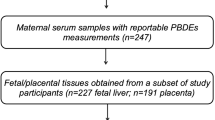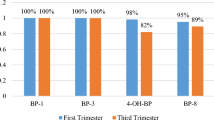Abstract
Objective:
The objective was to determine whether bisphenol-A (BPA) is found in maternal circulation of pregnant women in the US population and is related to gestational length and birth weight.
Method:
Circulating levels of BPA were quantified by high performance liquid chromatography-tandem mass spectrometry at delivery in 40 southeastern Michigan mothers and correlated with gestational length and birth weight of offspring.
Result:
Maternal levels of unconjugated BPA ranged between 0.5 and 22.3 ng ml−1 in southeastern Michigan mothers. There was no correlation between BPA concentrations and gestational length or birth weight of offspring.
Conclusion:
This is the first study to document measurable levels of BPA in maternal blood of the US population. Long-term follow-up studies of offspring are needed to validate or refute concerns over human fetal exposure to synthetic exogenous steroids.
This is a preview of subscription content, access via your institution
Access options
Subscribe to this journal
Receive 12 print issues and online access
$259.00 per year
only $21.58 per issue
Buy this article
- Purchase on Springer Link
- Instant access to full article PDF
Prices may be subject to local taxes which are calculated during checkout



Similar content being viewed by others
References
Damstra T, Barlow S, Bergman A, Kavlock R, Van der Kraak G . Global Assessment of the State-of-the-Science of Endocrine Disruptors. International Programme on Chemical Safety (IPCS). World Health organization: Geneva, Switzerland, 2002.
Gierthy JF . Testing for endocrine disruption: how much is enough? Toxicol Sci 2002; 68: 1–3.
Welshons WV, Nagel SC, vom Saal FS . Large effects from small exposures. III. Endocrine mechanisms mediating effects of bisphenol A at levels of human exposure. Endocrinology 2006; 147: s56–s69.
vom Saal FS, Huges C . An extensive new literature concerning low-dose effects of bisphenol A shows the need for a new risk assessment. Environ Health Perspect 2005; 113: 926–933.
Brotons JA, Olea-Serrano MF, Villalobos M, Pedraza V, Olea N . Xenoestrogens released from lacquer coatings in food cans. Environ Health Perspect 1995; 103: 608–612.
Kuo H-W, Ding W-H . Trace determination of bisphenol A and phytoestrogens in infant formula powders by gas chromatography-mass spectrometry. J Chromatogr A 2004; 1027: 67–74.
Munguia-Lopez EM, Gerardo-Lugo S, Peralta E, Bolumen S, Soto-Valdez H . Migration of bisphenol A (BPA) from can coatings into a fatty-food simulant and tuna fish. Food Addit Contam 2005; 22: 892–898.
Thomson BM, Grounds PR . Bisphenol A in canned foods in New Zealand: an exposure assessment. Food Addit Contam 2005; 22: 65–72.
Boyd GR, Palmeri JM, Zhang S, Grimm DA . Pharmaceuticals and personal care products (PPCPs) and endocrine disrupting chemicals (EDCs) in stormwater canals and Bayou St John in New Orleans, Louisiana, USA. Sci Total Environ 2004; 333: 137–148.
Khim JS, Lee KT, Villeneuve DL, Kannan K, Giesy JP, Koh CH . In vitro bioassay determination of dioxin-like and estrogenic activity in sediment and water from Ulsan Bay and its vicinity, Korea. Arch Environ Contam Toxicol 2001; 40: 151–160.
Loos R, Hanke G, Eisenreich SJ . Multi-component analysis of polar water pollutants using sequential solid-phase extraction followed by LC-ESI-MS. J Environ Monit 2003; 5: 384–394.
Rudel RA, Brody JG, Spengler JD, Vallarino J, Geno PW, Sun G et al. Identification of selected hormonally active agents and animal mammary carcinogens in commercial and residential air and dust samples. J Air Waste Manag Assoc 2001; 51: 499–513.
Dodds E, Lawson W . Molecular structure in relation to oestrogenic activity. Compounds without a phenanthrene nucleus. Proc R Soc Lond B 1938; 125: 222–232.
Matthews JB, Twomey K, Zacharewski TR . In vitro and in vivo interactions of bisphenol A and its metabolite, bisphenol A glucuronide, with estrogen receptors alpha and beta. Chem Res Toxicol 2001; 14: 149–157.
Wetherill YB, Akingbemi B, Kenno J, McLachlan JA, Nadal A, Sonnenschein C et al. In vitro molecular mechanisms of bisphenol A action. Reprod Toxicol 2007; 24: 178–198.
Zoeller RT, Bansal R, Parris C . Bisphenol-A, an environmental contaminant that acts as a thyroid hormone receptor antagonist in vitro, increases serum thyroxine, and alters RC3/Neurogranin expression in the developing rat brain. Endocrinology 2005; 146: 607–612.
Elsby R, Maggs JL, Ashby J, Park BK . Comparison of the modulatory effects of human and rat liver microsomal metabolism on the estrogenicity of bisphenol A: implications for extrapolation to humans. J Pharmacol Exp Ther 2001; 297: 103–113.
Nunez A, Kannan K, Giesy J, Fang J, Clemens L . Effects of bisphenol A on energy balance and accumulation in brown adipose tissue in rats. Chemosphere 2001; 42: 917–922.
Takeuchi T, Tsutsumi O, Ikezuki Y, Takai Y, Taketani Y . Positive relationship between androgen and the endocrine disruptor, bisphenol A, in normal women and women with ovarian dysfunction. Endocr J 2004; 51: 165–169.
Abbott DH, Barnett DK, Bruns CM, Dumesic DA . Androgen excess fetal programming of female reproduction: a developmental aetiology for polycystic ovary syndrome? Hum Reprod Update 2005; 11: 357–374.
Padmanabhan V, Manikkam M, Recabarren S, Foster DL . Prenatal testosterone programs reproductive and metabolic dysfunction in the female. Mol Cell Endocrinol 2006; 246: 165–174.
Crespi EJ, Steckler TL, MohanKumar PS, Padmanabhan V . Prenatal exposure to excess testosterone modifies the developmental trajectory of the insulin-like growth factor system in female sheep. J Physiol 2006; 572: 119–130.
Manikkam M, Crespi EJ, Doop DD, Herkimer C, Lee JS, Yu S et al. Fetal programming: prenatal testosterone excess leads to fetal growth retardation and postnatal catch-up growth in sheep. Endocrinology 2004; 145: 790–798.
Steckler T, Wang J, Bartol F, Roy SK, Padmanabhan V . Fetal programming: prenatal testosterone treatment causes intrauterine growth retardation, reduces ovarian reserve and increases ovarian follicular recruitment. Endocrinology 2005; 146: 3185–3193.
Giusti RM, Iwamoto K, Hatch EE . Diethylstilbestrol revisited: a review of the long-term health effects. Ann Intern Med 1995; 122: 778–788.
Savabieasfahani M, Kannan K, Astapova O, Evans N, Padmanabhan V . Developmental programming: differential effects of prenatal exposure to bisphenol-A or methoxychlor on reproductive function. Endocrinology 2006; 147: 5956–5966.
Ikezuki Y, Tsutsumi O, Takai Y, Kamei Y, Taketani Y . Determination of bisphenol A concentrations in human biological fluids reveals significant early prenatal exposure. Hum Reprod 2002; 17: 2839–2841.
Schonfelder G, Wittfoht W, Hopp H, Talsness CE, Paul M, Chahoud I . Parent bisphenol A accumulation in the human maternal-fetal-placental unit. Environ Health Perspect 2002; 110: A703–A707.
Yamada H, Furuta I, Kato EH, Kataoka S, Usuki Y, Kobashi G et al. Maternal serum and amniotic fluid bisphenol A concentrations in the early second trimester. Reprod Toxicol 2002; 16: 735–739.
Brock JW, Yoshimura Y, Barr JR, Maggio VL, Graiser SR, Nakazawa H et al. Measurement of bisphenol A levels in human urine. J Expo Anal Environ Epidemiol 2001; 11: 323–328.
Calafat A, Kuklenyik Z, Reidy J, Caudill S, Ekong J, Needham L . Urinary concentrations of bisphenol A and 4-nonylphenol in a human reference population. Environ Health Perspect 2005; 113: 391–395.
Wolff MS, Teitelbaum SL, Windham G, Pinney SM, Britton JA, Chelimo C et al. Pilot study of urinary biomarkers of phytoestrogens, phthalates, and phenols in girls. Environ Health Perspect 2007; 115: 116–121.
Dekant W, Lederer E, Wolf N, Colnot T, Volkel W . Toxicokinetics of bisphenol A in human subjects. Toxicol Sci 2002; 66 (suppl): 227.
Knaak JB, Sullivan LJ . Metabolism of bisphenol A in the rat. Toxicol Appl Pharmacol 1966; 8: 175–184.
Pottenger LH, Domoradzki JY, Markham DA, Hansen SC, Cagen SZ, Waechter Jr JM . The relative bioavailability and metabolism of bisphenol A in rats is dependent upon the route of administration. Toxicol Sci 2000; 54: 3–18.
Coughtrie MW, Burchell B, Leakey JE, Hume R . The inadequacy of perinatal glucuronidation: immunoblot analysis of the developmental expression of individual UDP-glucuronosyltransferase isoenzymes in rat and human liver microsomes. Mol Pharmacol 1988; 34: 729–735.
Takahashi O, Oishi S . Disposition of orally administered 2, 2-Bis(4-hydroxyphenyl) propane (Bisphenol A) in pregnant rats and the placental transfer to fetuses. Environ Health Perspect 2000; 108: 931–935.
Alonso-Magdalena P, Morimoto S, Ripoll C, Fuented E, Nadal A . The estrogenic effect of bisphenol A disrupts pancreatic beta-cell function in vivo and induces insulin resistance. Environ Health Perspect 2006; 114: 106–112.
Durando K, kass L, Piva J, Sonnenschein C, Soto AM, Luque EH et al. Prenatal bisphenol A exposure induces preneoplastic lesions in the mammary gland in Wistar rats. Environ Health Perspect 2007; 115: 80–86.
Kubo K, Arai O, Omura M, Watanabe R, Ogata R, Aou S . Low dose effects of bisphenol A on sexual differentiation of the brain and behavior in rats. Neurosci Res 2003; 45: 345–356.
Timms BG, Howdeshell KL, Barton L, Bradley S, Richter CA, vom Saal FS . Estrogenic chemicals in plastic and oral contraceptives disrupt development of the fetal mouse prostate and urethra. Proc Natl Acad Sci USA 2005; 102: 7014–7019.
Goodman JE, McConnell EE, Sipes IG, Witorsch RJ, Slayton TM, Yu CJ et al. An updated weight of the evidence evaluation of reproductive and developmental effects of low doses of bisphenol A. Crit Rev Toxicol 2006; 36: 387–457.
Kamrin MA . The ‘low dose’ hypothesis: validity and implications for human risk. Int J Toxicol 2007; 26: 13–23.
Cooke RW . Conventional birth weight standards obscure fetal growth restriction in preterm infants. Arch Dis Child Fetal Neonatal Ed 2007; 92: F189–F192.
Hoyert DL, Mathews TJ, Menacker F, Strobino DM, Guyer B . Annual summary of vital statistics: 2004. Pediatrics 2006; 117: 168–183.
Gee GC, Payne-Sturges DC . Environmental health disparities: a framework integrating psychosocial and environmental concepts. Environ Health Perspect 2004; 112: 1645–1653.
Olden K, White SL . Health-related disparities: influence of environmental factors. Med Clin North Am 2005; 89: 721–738.
Silbergeld EK, Patrick TE . Environmental exposures, toxicologic mechanisms, and adverse pregnancy outcomes. Amer J Obstet & Gynecol 2005; 192 (Suppl): S11–S21.
Lewis LB, Sloane DC, Nascimento LM, Diamant AL, Guinyard JJ, Yancey AK et al. REACH African americans’ access to healthy food options in south los angeles restaurants. Am J Public Health 2005; 95: 668–673.
Zenk SN, Schulz AJ, Israel BA, James SA, Bao S, Wilson ML . Fruit and vegetable access differs by community racial composition and socioeconomic position in Detroit, Michigan. Ethn Dis 2006; 16: 275–280.
Acknowledgements
We thank Dr Mohan Manikkam and Mr James S Lee for assistance with the processing of human blood samples and procurement of sheep blood samples, respectively. This study was supported by P20RR020682 from the National Institutes of Health.
Author information
Authors and Affiliations
Corresponding author
Rights and permissions
About this article
Cite this article
Padmanabhan, V., Siefert, K., Ransom, S. et al. Maternal bisphenol-A levels at delivery: a looming problem?. J Perinatol 28, 258–263 (2008). https://doi.org/10.1038/sj.jp.7211913
Received:
Revised:
Accepted:
Published:
Issue Date:
DOI: https://doi.org/10.1038/sj.jp.7211913
Keywords
This article is cited by
-
Suppression of trinucleotide repeat expansion in spermatogenic cells in Huntington’s disease
Journal of Assisted Reproduction and Genetics (2022)
-
Developmental exposure of California mice to endocrine disrupting chemicals and potential effects on the microbiome-gut-brain axis at adulthood
Scientific Reports (2020)
-
Effect of bisphenols on telomerase expression and activity in breast cancer cell lines
Molecular Biology Reports (2020)
-
Prenatal maternal and childhood bisphenol a exposure and brain structure and behavior of young children
Environmental Health (2019)
-
Fetal growth in environmental epidemiology: mechanisms, limitations, and a review of associations with biomarkers of non-persistent chemical exposures during pregnancy
Environmental Health (2019)



